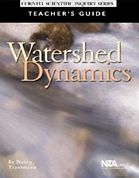 Watersheds
Watersheds
Where does your drinking water come from? Is it treated before it comes into
your home? If so, where is it treated, and how? Clean water is essential to
life, but many people are unfamiliar with the answers to these and related
questions. By encouraging students to do authentic scientific research on the
watersheds in their communities, EI facilitates a better understanding of water
resources and the scientific process.
What is a watershed?
A watershed
is the area of land that drains into a stream, river, lake, or other body of
water. Watersheds can be both large and small. For example, a small stream
in a rural neighborhood may have a tiny watershed. In contrast, the Mississippi
River's watershed covers almost two-thirds of North America!
Consider a small stream high in the mountains. Its watershed
consists of the few underground springs and precipitation runoff from the land
just above it. As the stream flows downhill, it enters successively larger
bodies of water, including a bigger stream, a river, perhaps a lake, and eventually
the ocean - all of which have correspondingly larger watersheds. Watersheds
of all sizes have complex processes affecting the quality of the water draining
out of them.
Of course, humans use water for drinking, cleaning, cooking,
and carrying away waste. To obtain water for these uses, we have built pipes,
dams, water treatment plants (both for treating water before it enters our
homes and after it leaves them), and other structures for transporting water.
Because we depend on water that is free of pollutants and as clean as possible,
it is often necessary to responsibly manage the watersheds that provide the
water we use. Indeed, many towns and cities have watershed management plans
to ensure the quality - and quantity - of their water sources.
As watersheds become developed, stormwater runs off from roads, fields, parking lots, and buildings. Roadside ditches are designed and managed to prevent flooding of these structures by providing rapid flow of runoff water. However, impacts on quantity and quality of water in streams and lakes typically is not considered when ditches are designed, built, and maintained. Through investigations of roadside ditches, students can learn about surface water runoff and its impact on downstream waters.
Student investigations of stormwater runoff in roadside ditches
 Cornell
Scientific Inquiry Series
Cornell
Scientific Inquiry Series
Watershed Dynamics, the fourth book in the Cornell Environmental
Inquiry Series, is a comprehensive guide to student watershed research. Learn
more Watershed Dynamics and download related files.
Other Ideas for Student Water Quality
Experiments (PDF files):
Watershed Links
GIS links
Watershed
resource links
EI's
Engineering Design Challenges
|
Copyright © 2009 Environmental Inquiry, Cornell
University and Penn State University
http://ei.cornell.edu |
 Watersheds
Watersheds